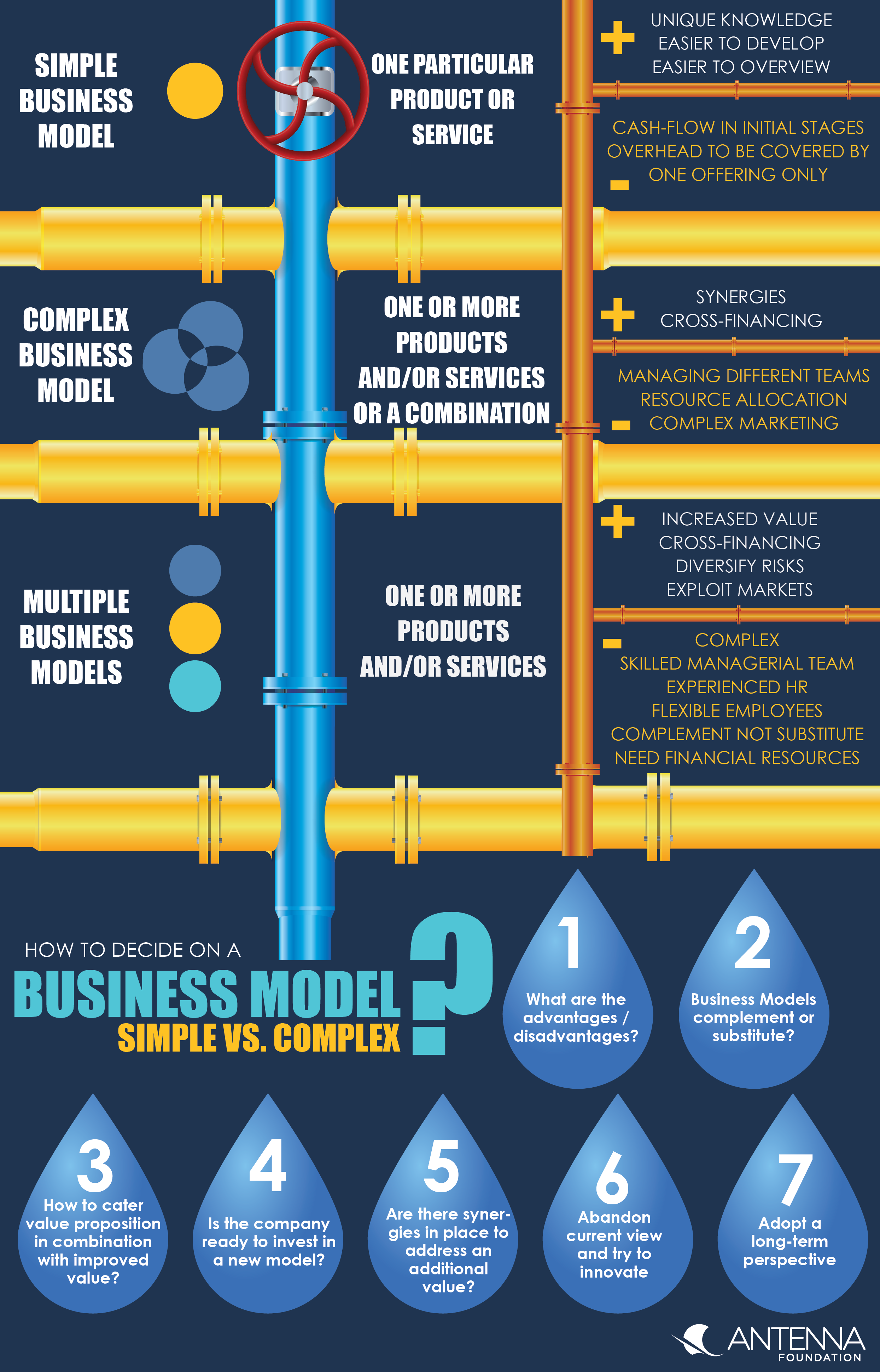Executive Summary

A business can operate with one (“simple”) or multiple (“complex”) business models, addressing one or multiple value propositions through one or multiple product or service offerings. Such business strategies can entail complementary products or a product that is complemented with a value adding service that is charged for. These strategies can leverage profitability and encompass a broader customer base as well as higher per customer turnover.
The case study of TARA in India provides insights of how a multiple business model in the safe water sector can increase the likeliness to breaking even.
What are simple and complex business models?
A simple business model addresses a value proposition through one particular product or service. A complex business model addresses a potentially broader value proposition through one or more products and services (SMITH ET AL., 2010). Multiple business models address multiple value propositions through one or more products and services. In order to understand this distinction of business models better, the table below provides definitions and examples:
|
| Simple Business Model | Complex Business Model | Multiple Business Models |
| Description | A simple business model addresses a value proposition through one particular product or service (compare value proposition). | A complex business model addresses a broader, more complex value proposition through one or more products and/or services or a combination of it. | Multiple business models address multiple value propositions through one or more products and/or services. |
| Advantages |
|
|
|
| Disadvantages |
|
|
(WEIR, 2012; CASADESUS-MASANELL & TARZIJÁN, 2012) |
| Example | ECCA is addressing the need of people to have an affordable water treatment product with selling its chlorine flask to customers. | Spring Health addresses convenience and safe water at once. Distributing safe water at the doorstep is very convenient, and aspirational. | TARA addresses different aspects with its market based development approach. Beside safe water, the creation of employment and development and dissemination of additional health-related products and technologies is fostered. |
Comparison of complexity of business models. Source: Antenna, 2018
Why consider having one or multiple business models?
It is not only important to assess the crucial elements of a business model as discussed in the previous sections (see factsheets on value proposition, value creation and value capture) but to consider also whether a business ought to operate with one or multiple business models. As a company starts out it may find that one single business model makes more sense to cater to a particular value proposition, while at later stages new value proposing markets might require entirely different business models. While a new business model might not be necessary in such case, modified or new products and services can entail complete reconfigurations of the existing business model so that it makes more sense to operate with multiple business models for the operations to function well (CHESBROUGH, 2010). Considering the way to go about commercialising new products and services can lead to more revenue streams and the option to diversify risk. For example, seasonality (people purchase less water during rainy season as additional sources of water are available as found by Spring Health) could make it useful for social enterprises to focus on differing markets to overcome low consumption and thus difficult cash flow periods.
For whom are one or multiple business models relevant?
Reflecting on simple or multiple business models is interesting for every safe water enterprise that is considering developing or launching new products, services, expanding to additional markets or would like to increase their revenue streams. In particular when reflecting on the development of new business models to commercialise additional products it is recommended to consider the aspect of simple or multiple business models, especially for safe water businesses working with bottom of the pyramid customers - which is per se a challenging environment asking for innovative ideas.
Subscribe here to the new Sanitation and Water Entrepreneurship Pact (SWEP) newsletter. SWEP is a network of organizations joining hands to help entrepreneurs design and develop lasting water and sanitation businesses.
How can one or multiple business models be implemented?
Methods to reflect on business model decisions - a participatory process with different stakeholders/employees of your company is key - workshop session where the strategy of the social business is discussed; applying the following methodologies:
- Design thinking including prototyping (after creating ideas to see whether it might be feasible or not):
- World Café
- Moderated discussion (with internal or external moderator)
- Group moderation and facilitation
These methodologies can be used to facilitate discussions. In order to take a decision on simple or multiple business models the following strategic aspects have to be considered:
- What are the advantages / disadvantages of a simple compared to a complex or multiple business model for your serving your specific value proposition in place?
- Make sure that the business models complement and do not substitute each other.
- What is the best solution in order to cater the value proposition in combination with improved value capture best?
- Is the company ready to invest in a new business model (money, time, human resources…)?
- Are there synergies in place that can be used addressing an additional value proposition?
- Abandon the view on the current business model and try to innovate
- Adopt a long-term perspective on your business activities, including a vision with milestones for 5, 10 and 20 years. Update this strategy every year. (CONVERSATION IN GROWTH, 2012)
The case study of TARA in India provides insights of how a multiple business model in the safe water sector can increase the likeliness to breaking even.
When One Business Model Isn’t Enough
Business Model Innovation: Opportunities and Barriers
Operating Multiple Business Models
Complex business models: Managing strategic paradoxes simultaneously
Developing a Multiple Business Model Strategy
Value proposition design: how to create products and services customers want
The book Value Proposition Design helps tackle the core challenge of every business - creating compelling products and services customers want to buy. This highly practical book, paired with its online companion, will teach you the processes and tools you need to design, test, create, and manage products and services customers actually want.
OSTERWALDER, A. et al. (2014): Value proposition design: how to create products and services customers want. John Wiley & Sons URL [Accessed: 09.11.2018]Business Models and Competitive Advantage
This paper discusses the topic of how enterprises can gain sustainable competitive advantages in emerging markets through multiple business models. A variety of case studies are developed to highlight the multiple business models in practice. The paper shows that firms studied applying multiple business models demonstrate higher chances of gaining competitive advantage.
Published under license: CC BY-NC-ND 4.0
RANJITH, V.K. (2016): Business Models and Competitive Advantage. In: Procedia Economics and Finance: Volume 37 , 2003-2007. URL [Accessed: 15.08.2018]Business models for shared value: Main report
This report on business models for shared value discusses how financial benefits can arise for enterprises that are responding to societal issues. The report provides a state-of-the-art overview of research and practice in this area.
LÜDEKE-FREUND, F. et al. (2016): Business models for shared value: Main report. Network for Business Sustainability South Africa URL [Accessed: 15.08.2018]Environmental Camps for Conservation Awareness
(ECCA) is an environmental organization that focuses on raising awareness through young people in schools, as pupils provide excellent communication channels with communities. ECCA aims to improve access to drinking water in schools and communities in central and eastern Nepal, through the bottling and sale of locally produced chlorine, branded WATASOL.
http://ecca.org.np/home [Accessed: 05.06.2018]Spring Health - What We Do
Spring Health is a water kiosk enterprise active in rural Odisha, India. At the doorstep via home delivery and at pick up points people purchase safe water in jerry cans. For more information please visit the homepage.
SPRING HEALTH (2017): Spring Health - What We Do. URL [Accessed: 10.04.2018]Technology & Action for Rural Advancement (TARA)
The Society for Technology & Action for Rural Advancement (TARA) is a social enterprise set up in the year 1985 at New Delhi, India. It is an "incubation engine" of the Development Alternatives Group which has been providing development solutions in India and elsewhere.
http://www.tara.in/about_us.aspx [Accessed: 15.08.2018]

